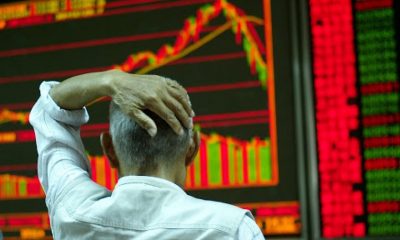Commodities
Energy & precious metals – weekly review and outlook

Federal Reserve boss Powell and his colleagues will need it to see if inflation indeed slows meaningfully if the central bank decides on its first rate hike pause in 18 months.
Meanwhile, at OPEC, Abdulaziz will require more patience than possibly anyone at the Fed as the oil cartel saw another loss in crude prices at the end of last week despite a highly-publicized Saudi output cut.
The Fed’s June policy-making on Wednesday is expected to vote for a break from a rate hike campaign that started 15 months ago – even as the central bank confronts a U.S. economy that’s resilient and feeding inflation despite persistent talk of recession.
Bloomberg provided a snapshot of analysts’ thoughts to see divided markets – and the Fed itself was on a stay in rates:
“Those who prefer to skip a hike in June want to wait and see – given the long and variable lags of monetary policy – how 500 basis points of rate hikes to date are cooling the economy. More hawkish members are convinced rates aren’t yet restrictive enough, and the Fed shouldn’t risk falling behind the curve. We see a ‘hawkish skip’ as a way to maintain unanimity on the committee.”
The U.S. Consumer Price Index hit 40-year highs in June 2022, expanding at an annual rate of 9.1%. Since then, it has slowed, growing at just 4.9% per annum in April, for its slowest expansion since October 2021. The Fed’s favorite price indicator, the Personal Consumption Expenditures, or PCE, Index, meanwhile, grew by 4.4% in April. Both the CPI and PCE are, however, still expanding at more than twice the Fed’s 2% per annum target for inflation.
Traders now have their eyes on the May CPI reading due Tuesday, a day before the Fed decision.
On the OPEC+front, crude prices finished Friday’s trading even lower than before last weekend’s meeting of the world’s top oil producers, where Saudi Arabia tried to “surprise” the market with another production cut.
That surprise is in inverted commas because many market watchers had already appeared to know that Minister Abdulaziz bin Salman and his Saud contingent would announce a unilateral output cut if there was no willingness by the rest to put up one.
The million-barrel cut that Abdulaziz tried to cutely label as a “Saudi lollipop” couldn’t sustain its sweetness beyond a couple of days.
After a fleeting pop of nearly 3% on Sunday and another 1% rebound on Wednesday, crude prices had fallen most this week.
The downside was distorted partly by a false report from a Middle East news portal on Thursday about a U.S.-Iran nuclear deal that could legitimately channel some sanctioned oil from Tehran to the market.
“It’s been a volatile week for oil prices, starting with the spike on the back of Saudi Arabia’s one million barrel production cut and ending with the US and Iran denying a temporary nuclear deal that saw prices plunge on Thursday,” said Craig Erlam, analyst at online trading platform OANDA. “These are very jittery markets against the backdrop of a deteriorating economic outlook.”
Erlam also noted that the Saudi production cut had little impact on the eventual price of oil.
With its latest maneuver on output, Saudi Arabia is effectively pledging to remove some 2.5M barrels per day from its production since October, versus a normal run of 11.5M barrels. The Saudi move came after its 12 partners in OPEC, or the Organization of the Petroleum Exporting Countries, and 10 other allies, including Russia, in the OPEC+ alliance decided to stay pat on production.
Reuters reported on Friday that the Saudis appeared to have caught those in OPEC+ unawares with their move. But almost all traders contacted by Investing.com seemed to have guessed the move, more because of Abdulaziz’s rabid obsession in trying to triumph against short-sellers in the market with his so-called production surprises that were losing their impact with each attempt of his.
“He’s fast becoming the court jester of OPEC with his dares against speculators,” said John Kilduff, partner at New York energy hedge fund Again Capital. “Instead of behaving in a dignified way appropriate for the head of OPEC+, he’s acting like a street brawler. These production cuts would have so much more impact if done sparingly, or even quietly. Let the data speak for itself. You always have your ‘gotcha’ moment with the market then.”
Erlam of OANDA agreed. “The Saudis are clearly not on the same page as their allies and are seemingly far more price obsessed,” the analyst said. “They won some concessions from (price projections for) 2024 but that’s a long time away and much can and probably will change in that time.”
The Saudi obsession with getting the market its way was reinforced by a Washington Post report on Friday that suggested that Crown Prince and king-in-waiting Mohammed bin Salman planned to hurt America in a big way if the Biden administration had retaliated against the kingdom’s deep oil production cuts that began eight months ago. The Post’s story was based on information embedded in dozens of highly-classified documents leaked online under a dossier called the ‘Discord Leaks’.
In what might give oil bulls a frisson of hope, the U.S. Department of Energy, or DoE, announced on Friday it has committed to buy approximately 6 million barrels of crude oil thus far to replenish the Strategic Petroleum Reserve, or SPR, which has seen draws of about 200 million barrels over the past year and a half.
A DoE statement said it was undertaking the “purchase of 3 million barrels and new solicitation for purchase of 3 million additional barrels [that] advances efforts to replenish the reserve at a good deal for American taxpayers, maintain the SPR’s operational readiness, and protect the nation’s energy security.”
Ten companies submitted 30 proposals in all to supply the first tranche of 3 million barrels, and five were successful, the DoE said.
“This purchase has been fully subscribed, and the contracts were awarded to five companies,” the statement said. “These 3 million barrels are being purchased for an average price of about $73 per barrel, lower than the average of about $95 per barrel that SPR crude was sold for in 2022, securing a good deal for taxpayers.”
The first tranche of oil, when ready for shipment, will be delivered to the Big Hill SPR storage site between August 1-31.
Despite the seemingly bullish element of the announcement, Anas Alhajji, a widely-followed energy market commentator on Twitter, said: “Oil bulls must realize that, if all stars line up for the Biden administration to refill the SPR with 180 million barrels, it needs about a year and half. If you do not know this, time to wake up!”
Oil: Market Settlements and Activity
New York-traded West Texas Intermediate, or WTI, crude ended Friday’s session at $70.35 – down $0.94, or 1.32%, on the day. It plunged to as low as $69.09 earlier, breaking the key $70 support.
London-traded Brent crude settled Friday’s session at $75.04 – down 92 cents, or 1.2%, on the day. Brent’s session low was $73.61, breaking its $75 support.
Oil: WTI Technical Outlook
The U.S. crude benchmark is expected to bounce around in the $75 to $67 region in the coming week, said Sunil Kumar Dixit, chief technical strategist at SKCharting.com.
“We expect sideways moves within the broader range of the Weekly Middle Bollinger Band of $74.90 as the resistance zone and the 200-week SMA, or Simple Moving Average of $67.25, as the horizontal support zone,” said Dixit.
He added that the Weekly Stochastics reading at 32/39 indicated a lack of bullish momentum.
Gold: Market Settlements and Activity
Gold was headed for a second straight weekly gain on Friday, posting its third rise in four days, amid bets the Federal Reserve will pause its rate hike cycle for the first time in 18 months.
The front-month gold contract on New York’s Comex settled at $1975.90 an ounce, down $2.70, or 0.14%, on the day. For the week, it was up 0.4%, about the same as the previous week.
The spot price of gold, which reflects physical trades in bullion and is more closely followed than futures by some traders, settled at $1,960.97, down $4.65, or 0.2% on the day. For the week, spot gold was up 0.7%, adding to the previous week’s near-flat close.
Bets for a Fed rate pause grew on Friday despite higher weekly unemployment claims among Americans.
According to Investing.com’s Fed Rate Monitor Tool, there is a 70.1% chance that the central bank will stand down from a rate hike when its policy-makers sit on June 14.
Ed Moya, analyst at online trading platform OANDA, said gold’s choppiness in recent weeks was due to a lack of conviction over the economy that hadn’t helped tip the market’s balance either way.
Tuesday’s CPI reading for May could “ultimately determine whether gold breaks higher once more with potential record high ambitions or continues to correct lower”, Moya added.
Gold: Spot Price Outlook
Thus far, gold has been showing a rebound from the horizontal support base formed between $1,932 and $1,942, said SKCharting’s Dixit.
“A rebound towards $1,973 remains within the boundaries of previous week’s high of $1,983,” Dixit said.
Clearing through the $1,975-$1,978 initial resistance zone will set stage for a retest of the swing high of $1,983, and on strong acceptance above this zone, resumption of an uptrend targeting $2,006 can be followed by the next Fibonacci level $2,015.”
On the flip side, a sustained break below 100-Day SMA of $1,937 will eventually extend the drop to $1,913-$1,910, Dixit said.
“Gold bears may be preparing for repositioning their shorts from the higher zone of $2,006-$2,015 for a better risk-vs-reward ratio eyeing for $1,910.”
Natural gas: Market Settlements and Activity
Natural gas futures limped in with a daily gain and a small weekly loss as market participants look beyond the first injection of above 100 billion cubic feet, or bcf, in the current storage season for the fuel in anticipation of near-term demand.
The front-month gas contract on the New York Mercantile Exchange’s Henry Hub registered a final post-settlement trade of $2.262 per mmBtu, or million metric British thermal units, after officially settling Friday’s session at $2.25, down 9.8 cents, or 4.2% on the day. For the week, the contract finished up 9 cents, or 4%, after the 15.6% plunge in the prior week.
“The second half of June into early July suggests that consistent heat isn’t too far off into the future and once that heat materializes demand will rebound,” analysts at Houston-based energy markets advisory Gelber & Associates said in a note.
The market appears to be starting to price this in and further bullish support may materialize, the Gelber note said.
The weekly rebound came after the Energy Information Administration, or EIA, reported a build of 104 billion cubic feet, or bcf, for gas inventories after the previous week’s 110 bcf.
With the latest stockpile increase, the EIA reported that total gas in underground caverns in the United States stood at 2.55 trillion cubic feet, or tcf – up 28.3 % from the year-ago level of 1.988 tcf and 16.1% higher than the five-year average of 2.197 tcf.
Just two weeks ago, Henry Hub’s benchmark gas contract hovered at 11-week highs of around $2.70, breaking out from the tight confines of mid-$2 pricing on the notion that the market may finally be turning the corner on fundamentals despite its oversupplied state.
But in recent days, it fell back to under $2.50, which has proven again to be a formidable barrier for gas bulls.
Natural gas: Price Outlook
Natural gas has to hold above $2.03 to avoid another plunge to sub-$2 levels, Dixit of SKCharting said.
“Gas bulls don’t appear ready yet to mark a bullish rebound, with the week-long price action lacking any significant moves, except for a pause in decline,” Dixit added.
“Sustainability below $2.27 indicates chances of a further consolidation towards the $2.13 support. Any sustained break below that risks a drop to $2.03, followed by a reach for the $1.944 horizontal support zone.”
He said the 100-Day SMA of $2.40 held the key for upward mobility towards the resistance zone set by the 5-month EMA, or Exponential Moving Average, of $2.67, which is closely followed by a swing high of $2.685.
Commodities
Oil prices rise; U.S. crude inventories plunge, Russia-Ukraine truce eyed
Commodities
India’s Reliance to stop buying Venezuelan oil over US tariffs, sources say
Commodities
Oil prices climb on Venezuela supply worries

 Forex3 years ago
Forex3 years agoForex Today: the dollar is gaining strength amid gloomy sentiment at the start of the Fed’s week

 Forex3 years ago
Forex3 years agoUnbiased review of Pocket Option broker

 Forex3 years ago
Forex3 years agoDollar to pound sterling exchange rate today: Pound plummeted to its lowest since 1985

 Forex3 years ago
Forex3 years agoHow is the Australian dollar doing today?

 Cryptocurrency3 years ago
Cryptocurrency3 years agoWhat happened in the crypto market – current events today

 World3 years ago
World3 years agoWhy are modern video games an art form?

 Commodities3 years ago
Commodities3 years agoCopper continues to fall in price on expectations of lower demand in China

 Economy3 years ago
Economy3 years agoCrude oil tankers double in price due to EU anti-Russian sanctions



































